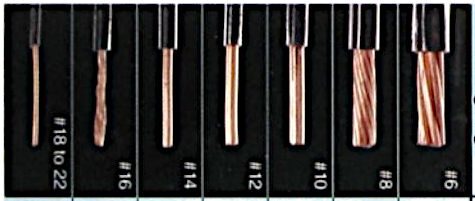How Thick is 14-Gauge Wire?

You may be wondering exactly how thick 14-gauge wire is, especially if you’ve been advised to replace 12- or 16-gauge wire.
14-gauge wire has a diameter of 0.0641 inches or 1.6277 mm, approximately 1/16 of an inch or 1.6 mm. It’s a little thicker than 16-gauge wire but thinner than 12-gauge wire. It is about as thick as a standard PCB or 16 sheets of paper. It’s usually required for a 15-amp circuit and some 10-amp ones, such as lighting fixtures.
Continue reading for more details.
Thickness of 14-gauge Wire
Exact Thickness
The exact thickness of a 14-gauge wire is 0.0641 inches. More details are given in the table below in different measures.

Normally, when we speak of “14-gauge wire” in the United States, we mean 14-gauge in the AWG (American Gauge Wire) system, also called the ‘Brown and Sharpe Wire Gauge.’ The exact diameter is 0.0641 inches (1.6277 mm), with a cross-sectional area of 0.0032 sq in (2.0809 mm2).
Note that this is the diameter of a solid wire, as a stranded wire has a slightly larger diameter due to the separate strands.
The 14-gauge AWG equivalent in the SWG (Standard Wire Gauge) system is a 16-gauge wire with a diameter of 0.064 inches (1.6256 mm), which is only slightly thinner.
The resistance of 14-gauge (copper) AWG wire per 1000 feet is 2.5194 Ω/kft (or 8.2656 Ω/km per 1000 m) at 20°C (68°F). The maximum current in amps is 32 for chassis wiring and 5.9 for power transfer.
Types
Below is a sample of 4 types of 14-gauge AWG wire.

Comparisons
A comparison of 14-gauge wire with other adjacent gauge wires can help to get an idea of how thick it is.
14-gauge wire is thicker than 16-gauge wire and thinner than 12-gauge wire. Refer to the chart below to see the difference.

If you need to decide between using a 14- or 16-gauge wire, usually for a 15-amp lighting circuit or as a boat cable, this is how the two look side-by-side:

Normally, a 15-amp circuit requires a 14-gauge wire, but a thinner 16-gauge wire may suffice for a lightweight (very low amperage) lighting fixture that doesn’t require a 15-amp circuit or has a long run. A 14-gauge wire will be better for preventing excess voltage drop over a long distance.
However, remember that a 14-gauge wire will be more expensive than a 16-gauge wire.
Approximations
It might make it easier to know how thick a 14-gauge wire is by comparing it with other known objects instead of knowing the exact size in inches or millimeters.
14-gauge wire is approximately 1/16 of an inch or 1.6 mm. It is about as thick as a standard PCB (printed circuit board), 16 sheets of paper, and a cassette cog, and half as thick as a plywood sheet or wall tile.
So, it’s stiff enough, not easily to bend by hand. Compared to thinner 16-gauge wire, 14-gauge wire is not as easy to bend around corners and snake through openings.
Uses of 14-Gauge Wire
Electrical Uses
14-gauge wire is designed to allow up to 15 amps of current to pass through, usually on a 120-volt circuit.
It’s usually required for appliances such as standard light fixtures. Outlets used for low-power electrical devices and appliances can usually operate on 14-gauge wire, but check the manufacturer’s recommendations to know for sure.
A few examples of low-power electrical devices and appliances (other than lighting fixtures) are:
- Doorbell
- Ceiling fan
- Smoke detector
- Television
A circuit that uses 14-gauge wire normally has 15-amp outlets and a 15-amp circuit breaker. GFCI protection is not usually required. So, if you see a 15-amp outlet or circuit breaker, it’s probably connected by a 14-gauge wire.
You should never use a 14-gauge wire on a 20-amp circuit. You will need a 12-gauge wire for that.

Creative Uses
The thickness and slight stiffness of 14-gauge wire make it useful in more ways than just letting up to 15 amps of electrical current pass through.
For example, you can use 14-gauge wire as a bracelet or to tie something.
References
Website Resources:
- 14-gauge silicone wire. https://www.acerracing.com/products/superworm-silicone-wire-14-gauge
- 14-gauge speaker wire. https://www.amazon.com/InstallGear-Gauge-100ft-Speaker-Touch/dp/B01CSZAYF0
- 14-gauge zip cord. https://www.pacergroup.net/14-gauge-zip-cord/
- Boat cable from 10- to 18-gauge. https://anaheimwire.online/boat-cable/
Books:
- B & D. The complete guide to home wiring: A comprehensive manual, from basic repairs to advanced projects. Black & Decker Home Improvement Library. Creative Publishing International. 2001
Video References:
The Home Depot
